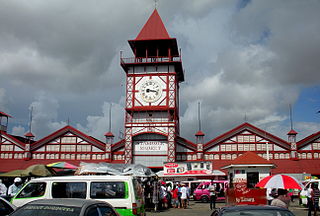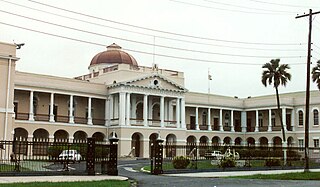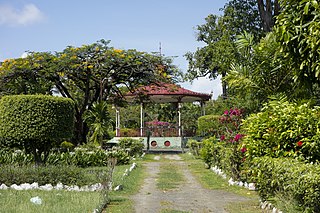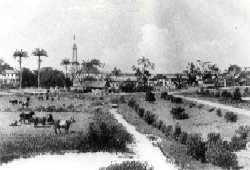
Georgetown is the capital and largest city of Guyana. It is situated in Demerara-Mahaica, region 4, on the Atlantic Ocean coast, at the mouth of the Demerara River. It is nicknamed the "Garden City of the Caribbean." It is the retail, administrative, and financial services centre of the country, and the city accounts for a large portion of Guyana's GDP. The city recorded a population of 118,363 in the 2012 census.

Cheddi Berret Jagan was a Guyanese politician and dentist who was first elected Chief Minister in 1953 and later Premier of British Guiana from 1961 to 1964. He later served as President of Guyana from 1992 to his death in 1997. In 1953, he became the first Hindu and person of Indian descent to be a head of government outside of the Indian subcontinent.

New Amsterdam is the regional capital of East Berbice-Corentyne, Guyana and one of the country's largest towns. It is 100 kilometres (62 mi) from the capital, Georgetown and located on the eastern bank of the Berbice River, 6 km (4 mi) upriver from its mouth at the Atlantic Ocean, and immediately south of the Canje River. New Amsterdam's population is 17,329 inhabitants as of 2012.

Linden Forbes Sampson Burnham was a Guyanese politician and the leader of the Co-operative Republic of Guyana from 1964 until his death in 1985. He served as Premier of British Guiana from 1964 to 1966, Prime Minister of Guyana from 1964 to 1980 and then as the first executive president of Guyana from 1980 to 1985. He is often regarded as a strongman who embraced his own version of socialism.

Stabroek Market is the largest market of Georgetown, Guyana. Located in the centre of the capital city, the market is housed in an iron and steel structure with a prominent clock tower.

The Parliament Building houses the National Assembly of Guyana, and is located in the capital Georgetown. The building was designed by Joseph Hadfield, and is located in Brickdam where the Court of Policy used to be. The building was completed on 21 February 1834. The Parliamentary Chamber contains a decorated ceiling designed by Cesar Castellani.
State House located in Georgetown, is the official residence of the president of Guyana. It was previously the official residence of the governor of British Guiana before the colony gained independence and became Guyana.
The Railways of Guyana comprised two public railways, the Demerara-Berbice Railway and the Demerara-Essequibo Railway. There are also several industrial railways mainly for the bauxite industry. The Demerara-Berbice Railway is the oldest in South America. None of the railways are in operation in the 21st century.

Georgetown City Hall is a nineteenth-century Gothic Revival building located on the corner of Regent Street and Avenue of the Republic in Georgetown, Guyana. The building was designed by architect Reverend Ignatius Scoles in 1887, and was completed in June 1889. The building houses the offices of the Mayor, the City Council, and the City Engineer.

The National Cultural Centre, the premier auditorium for cultural presentations in Georgetown, Guyana. It is on Homestretch Avenue, in D’Urban Park. It hosts theatre, music, and dance as well as other events.

The Sea Wall is a 280-mile seawall that runs along much of Guyana's coastline, including all of the coastline in the capital city of Georgetown. It protects settlements in the coastal areas of Guyana, most of which are below sea level at high tide.
Cesar Castellani was an architect. He was born in Malta. He was attracted by the prosperity of British Guiana and emigrated there in 1860 with a group of Italian priests.

Emerson Augustus Samuels was a prominent Guyanese graphic artist. He is perhaps best known for his portrait of Guyana President Forbes Burnham, completed in August 1984, which hangs in the Parliament Chamber.
Oswald ("Ossie") Hussein is a Guyanese artist of Lokono (Arawak) descent. Though he occasionally works in other mediums, he is best known for his wooden sculptures, which explore various dimensions of Arawak Amerindian culture and tradition. Hussein first achieved national recognition when he won first prize in Guyana's National Exhibition of the Visual Arts in 1989, and since that time he has gone on to become one of Guyana's most celebrated artists and a leading figure in Guyanese sculpture. Along with his half-brother, George Simon, he is one of the most prominent members of the Lokono Artists Group. His work has been displayed in numerous exhibitions in Guyana, Barbados, and the United Kingdom.
George Samuel Jenman (1845-1902) was a British gardener and botanist. He specialized in growing and studying plants. He was superintendent of Castleton Botanical Garden, Jamaica from 1873 to 1879, and Government Botanist and superintendent of the Botanical Gardens in British Guiana from 1879 to 1902. Jenman was also a member of the Linnean Society.

Guyana Botanical Gardens is a tropical botanical garden in Georgetown, Guyana. It is next to the Guyana Zoo and Castellani House.

Red House located in Kingston, Georgetown, was the official residence of the Colonial Secretary and later the Premier of British Guiana. As of 22 March 2000, it houses the Cheddi Jagan Research Centre.

Kingston is a former village in Demerara. In 1837, it became a ward of Georgetown. The ward is located along the Atlantic Ocean coast. Kingston is home to many landmarks and historic buildings.

Austin House located in Georgetown, is the official residence of the Anglican Bishop of Guyana. The building is named after William Piercy Austin, the first Anglican bishop of Guyana.

Philip Moore was a self-taught Guyanese sculptor and painter known for designing the 1763 Monument in Georgetown, Guyana. During his career, he held artist residencies at Livingstone College and Princeton University where he taught wood sculpture. In 1941, he became a Grand Master of the Jordanite religion, and considered his faith to be an integral part of his practice and teaching.
















